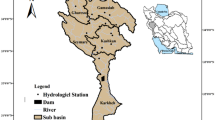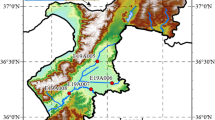Abstract
Investigation on drought characteristics such as severity, duration, and frequency is crucial for water resources planning and management in a river basin. While the methodology for multivariate drought frequency analysis is well established by applying the copulas, the estimation on the associated parameters by various parameter estimation methods and the effects on the obtained results have not yet been investigated. This research aims at conducting a comparative analysis between the maximum likelihood parametric and non-parametric method of the Kendall \(\tau \) estimation method for copulas parameter estimation. The methods were employed to study joint severity–duration probability and recurrence intervals in Karkheh River basin (southwest Iran) which is facing severe water-deficit problems. Daily streamflow data at three hydrological gauging stations (Tang Sazbon, Huleilan and Polchehr) near the Karkheh dam were used to draw flow duration curves (FDC) of these three stations. The \(Q_{75}\) index extracted from the FDC were set as threshold level to abstract drought characteristics such as drought duration and severity on the basis of the run theory. Drought duration and severity were separately modeled using the univariate probabilistic distributions and gamma–GEV, LN2–exponential, and LN2–gamma were selected as the best paired drought severity–duration inputs for copulas according to the Akaike Information Criteria (AIC), Kolmogorov–Smirnov and chi-square tests. Archimedean Clayton, Frank, and extreme value Gumbel copulas were employed to construct joint cumulative distribution functions (JCDF) of droughts for each station. Frank copula at Tang Sazbon and Gumbel at Huleilan and Polchehr stations were identified as the best copulas based on the performance evaluation criteria including AIC, BIC, log-likelihood and root mean square error (RMSE) values. Based on the RMSE values, nonparametric Kendall-\(\tau \) is preferred to the parametric maximum likelihood estimation method. The results showed greater drought return periods by the parametric ML method in comparison to the nonparametric Kendall \(\tau \) estimation method. The results also showed that stations located in tributaries (Huleilan and Polchehr) have close return periods, while the station along the main river (Tang Sazbon) has the smaller return periods for the drought events with identical drought duration and severity.









Similar content being viewed by others
References
Acciolya R D E and Chiyoshi F Y 2004 Modeling dependence with copulas: A useful tool for field development decision process; J. Petrol. Sci. Eng. 44(1–2) 83–91.
Bonaccorso B, Cancelliere A and Rossi G 2003 An analytical formulation of return period of drought severity; Stoch. Environ. Res. Risk A. 17(3) 157–174.
Breymann W, Dias A and Embrechts P 2003 Dependence structure for multivariate high-frequency data in finance; Quant. Struct. Act. Rel. 3(1) 1–14.
Cancelliere A and Salas J D 2004 Drought length properties for periodic-stochastic hydrologic data; Water Resour. Res. 40 W02503, doi: 10.1029/2002WR001750.
Chang J, Li Y, Wang Y and Yuan M 2016 Copula-based drought risk assessment combined with an integrated index in the Wei River Basin, China; J. Hydrol. 540 824–834.
De Michele C, Salvadori G, Vezzoli R and Pecora S 2013 Multivariate assessment of droughts: Frequency analysis and dynamic return period; Water Resour. Res. 49(10) 6985–6994.
Dodangeh E, Soltani S, Sarhadi A and Shiau J T 2014 Application of L-moments and Bayesian inference for low-flow regionalization in Sefidroud basin, Iran; Hydrol. Process. 28(4) 1663–1676.
Edossa D C, Babel M S and Gupta A D 2010 Drought analysis in the Awash River basin, Ethiopia; Water Resour. Manag. 24(7) 1441–1460.
Favre A C, Adlouni S E, Perreault L, Thiemonge N and Bobbe B 2004 Multivariate hydrological frequency analysis using copulas; Water Resour. Res. 40 1–12.
Fermanian J D 2005 Goodness-of-fit tests for copulas; J. Multivariate Anal. 95(1) 119–152.
Fleig A K, Tallaksen L M, Hisdal H and Demuth S 2006 A global evaluation of streamflow drought characteristics; Hydrol. Earth Syst. Sci. 10(4) 535–552.
Fu G and Butler D 2014 Copula-based frequency analysis of overflow and flooding in urban drainage systems; J. Hydrol. 510 49–58.
Genest C and Rivest L P 1993 Statistical-inference procedures for bivariate Archimedean copulas; JASA 88(423) 1034–1043.
Genest C, Quessy J F and Rémillard 2006 Goodness-of-fit procedures for copula models based on the probability integral transformation; Scand. J. Stat. 33(2) 337–366.
González J and Valdés J B 2003 Bivariate drought recurrence analysis using tree ring reconstructions; J. Hydrol. Eng. 8(5) 247–258.
He B, Lu A F, Wu J J, Zhao L and Liu M 2011 Drought hazard assessment and spatial characteristics analysis in China; J. Geogr. Sci. 21(2) 235–249.
Hisdal H and Tallaksen L M 2000 Drought event definition. Technical report to the ARIDE Project No. 6: Supple-ment to Work Package 2 Hydro-meteorological Drought Activity 2.1 Event Definition, 41p.
Jamali S, Abrishamchi A, Marino A M and Abbasnia A 2013 Climate change impact assessment on hydrology of Karkheh Basin, Iran; Proceedings of the Institution of Civil Engineers - Water Management 166(2) 93–104.
Kao S C and Govindaraju R S 2010 A copula-based joint deficit index for droughts; J. Hydrol. 380 121–134.
Kim T W, Valdes J B and Yoo C 2006 Nonparametric approach for bivariate drought characterization using Palmer drought index; J. Hydrol. Eng. 11(2) 134–143.
Kirby M, Mainuddin M, Ahmad M, Marchand P and Zhang L 2006 Water use account spreadsheets with examples of some major river basins; In: 9th Int. River Symposium, Brisbane, Australia.
Lana X and Burgueno A 1998 Spatial and temporal characterization of annual extreme droughts in Catalonia (northeast Spain); J. Climatol. 18(1) 93–110.
Lee K S, Sadeghipour J and Dracup J A 1986 An approach for frequency analysis of multiyear drought durations; Water Resour. Res. 22(5) 655–662.
Lee T, Modarres R and Ouarda T B M J 2013 Data-based analysis of bivariate copula tail dependence for drought duration and severity; Hydrol. Process. 27(10) 1454–1463.
Liu C L, Zhang Q, Singh V P and Cui Y 2011 Copula-based evaluations of drought variations in Guangdong, South China; Nat. Hazards 59(3) 1533–1546.
Loáiciga H A 2005 On the probability of droughts: The compound renewal model; Water Resour. Res. 41(1) W01009, doi: 10.1029/2004WR003075.
Madadgar S and Moradkhani H 2013 Drought analysis under climate change using copula; J. Hydrol. Eng. 18(7) 746–759.
Madsen H and Rosbjerg D 1995 On the modelling of extreme droughts; In: Proceedings of Modelling and Management of Sustainable Basin-Scale Water Resource Systems, IAHS Publications, Oxfordshire, 231 377–385.
Marjanizadeh S, Qureshi A S, Turral H and Talebzadeh P 2009 From Mesopotamia to the third millennium: The historical trajectory of water development and use in the Karkheh River Basin, Iran; Colombo, Sri Lanka, International Water Management Institute, 51p. (IWMI Working Paper 135), doi: 10.3910/2010.206.
Mirakbari M, Ganji A and Fallah S R 2010 Regional bivariate frequency analysis of meteorological droughts; J. Hydrol. Eng. 15(12) 985–1000.
Mishra A K and Singh V P 2010 A review of drought concepts; J. Hydrol. 391 202–216.
Modarres R 2008 Regional frequency distribution type of low flow in north of Iran by L-moments; Water Resour. Manag. 22(7) 823–841.
Modarres R 2010 Regional dry spells frequency analysis by L-moment and multivariate analysis; Water Resour. Manag. 24(10) 2365–2380.
Modarres R and Sarhadi A 2010 Frequency distribution of extreme hydrologic drought of southeastern semiarid region, Iran; J. Hydrol. Eng. 15(4) 255–264.
Muthuwatta L P, Ahmad M U D, Bos M G and Rientjes T H M 2010 Assessment of water availability and consumption in the Karkheh River basin, Iran – Using remote sensing and geo-statistics; Water Resour. Manag. 24(3) 459–484.
Nelsen R B 2006 An Introduction to Copulas; Springer, New York.
Palaro H and Hotta L K 2006 Using conditional copulas to estimate value at risk; J. Data Sci. 4(1) 93–115.
Patton A J 2006 Estimation of multivariate models for time series of possibly different lengths; J. Appl. Econometr. 21(2) 147–173.
Rao A R and Hamed K H 2000 Flood Frequency Analysis; CRC, Boca Raton, FL.
Reddy M J and Ganguli P 2012 Application of copulas for derivation of drought severity–duration–frequency curves; Hydrol. Process. 26(11) 1672–1685.
Reilly C F and Kroll C N 2003 Estimation of 7-day, 10-year low-streamflow statistics using baseflow correlation; Water Resour. Res. 39(9) 1236, doi: 10.1029/2002WR001740.
Sadri S and Burn D H 2014 Copula-based pooled frequency analysis of droughts in the Canadian Prairies; J. Hydrol. Eng. 19(2) 277–289.
Saghafian B and Mehdikhani H 2014 Drought characterization using a new copula-based trivariate approach; Nat. Hazards 72(3) 1391–1407.
Serinaldi F, Bonaccorso B, Cancelliere A and Grimaldi S 2009 Probabilistic characterization of drought properties through copulas; Phys. Chem. Earth 34(10–12) 596–605.
Shafer B A and Dezman L E 1982 Development of a surface water supply index (SWSI) to assess the severity of drought conditions in snowpack runoff areas; In: Western Snow Conference, Olorado State University, Reno, NV, pp. 164–175.
Sharma T C and Panu U S 2014 A simplified model for predicting drought magnitudes: A case of streamflow droughts in Canadian Prairies; Water Resour. Manag. 28(6) 1597–1611.
Shamaeizadeh M 2009 Low flow regionalization in northern Karoon; Isfahan University of Technology (in Persian).
Shiau J T 2006 Fitting drought duration and severity with two-dimensional copulas; Water Resour. Manag. 20(5) 795–815.
Shiau J T, Feng S and Nadaraiah S 2007 Assessment of hydrological droughts for the Yellow River, China, using copulas; Hydrol. Process. 21(16) 2157–2163.
Shiau J T and Hsiao Y Y 2012 Water-deficit-based drought risk assessments in Taiwan; Nat. Hazards 64(1) 237–257.
Shiau J T and Modarres R 2009 Copula based drought severity–duration–frequency analysis in Iran; Meteorol. Appl. 16(4) 481–489.
Shiau J T, Modarres R and Nadarajah S 2012 Assessing multi-site drought connections in Iran using empirical copulas; Environ. Model Assess. 17(5) 469–482.
Shiau J T and Shen H W 2001 Recurrence analysis of hydrologic droughts of differing severity; J. Water Resour. Plan. Manag. 127(1) 30–40.
Shumway R H and Stoffer D S 2011 Time Series Analysis and its Applications; Springer, New York.
Sklar M 1959 Fonctions de r’epartition ‘a n dimensions et leurs marges; Publ. Inst. Statist. Univ. Paris 8 229–231.
Smakhtin V U 2001 Low flow hydrology: A review; J. Hydrol. 240 147–186.
Tallaksen L M, Madsen H and Clausen B 1997 On the definition and modelling of streamflow drought duration and deficit volume; Hydrol. Sci. J. 42(1) 15–33.
Tosunoglu F and Kisi O 2016 Joint modeling of annual maximum drought severity and corresponding duration; J. Hydrol. 543 406–422, doi: 10.1016/j.jhydrol.2016.10.018.
Vergni L, Todisco F and Mannocchi F 2015 Analysis of agricultural drought characteristics through a two-dimensional copula; Water Resour. Manag. 29(8) 2819–2835.
Weghorst K M 1996 The Reclamation Drought Index: Guidelines and Practical Applications; Bureau of Reclamation, Denver, D-8530.
Wu Z, Lin Q, Lu G, He H and Qu J J 2015 Analysis of hydrological drought frequency for the Xijiang River basin in south China using observed streamflow data; Nat. Hazards 77(3) 1655–1677.
Xu K, Yang D, Yang H, Li Z, Qin Y and Shen Y 2015 Spatio-temporal variation of drought in China during 1961–2012: A climatic perspective; J. Hydrol. 526 253–264.
Xu K, Yang D, Xu X and Lei H 2015 Copula based drought frequency analysis considering the spatio-temporal variability in southwest China; J. Hydrol. 527 630–640.
Yevjevich V 1967 Objective approach to definitions and investigations of continental hydrologic droughts; Hydrology Paper 23, Colorado State University, Fort Collins.
Zarch M A A, Malekinezhad H, Mobin M H, Dastorani M T and Kousari M R 2011 Drought monitoring by reconnaissance drought index (RDI) in Iran; Water Resour. Manag. 25(13) 3485–3504.
Zhang Q, Xiao M, Singh V P and Chen X 2013 Copula-based risk evaluation of hydrological droughts in the East River basin, China; Stoch. Environ. Res. Risk A. 27(6) 1397–1406.
Acknowledgements
The authors would like to thank Iran Ministry of Power for their kind help and technical support for providing the data for this study. The authors also appreciate the comments provided by two anonymous reviewers.
Author information
Authors and Affiliations
Corresponding author
Additional information
Corresponding editor: Prashant K Srivastava.
Rights and permissions
About this article
Cite this article
Dodangeh, E., Shahedi, K., Shiau, JT. et al. Spatial hydrological drought characteristics in Karkheh River basin, southwest Iran using copulas. J Earth Syst Sci 126, 80 (2017). https://doi.org/10.1007/s12040-017-0863-6
Received:
Revised:
Accepted:
Published:
DOI: https://doi.org/10.1007/s12040-017-0863-6




